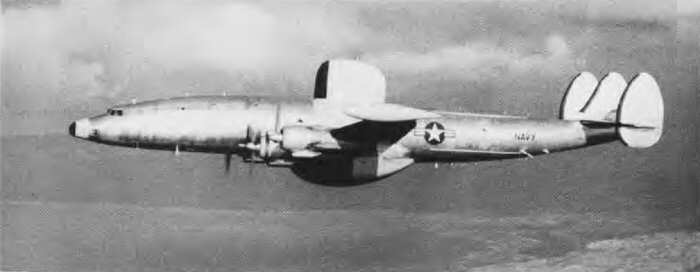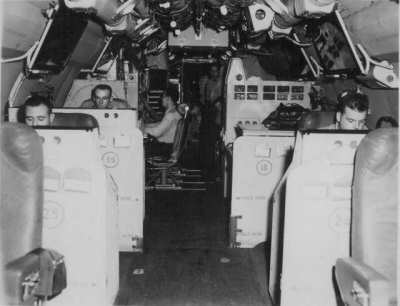
VIGILANCE is maintained by men and equipment of Airborne Early Warning Squadron One in this huge special equipped Super-Contellation WV-2 aircraft. The flying radar station with its six tons of radar gear capitalizes on height for detection of intruders.
FROM AN AERIAL command post in the Navy's new early warning airplanes, 26 men and six tons of radar equipment stand guard. Their early warning mission is carried on despite fog or rain or darkness.
The men are flying in one of the Navy's new WV-2's. Six tons of radar roaring through the sky can spot "enemy" invaders and direct their destruction without ever actually seeing the intruder.
Flying WV-2 Super Constellations crammed with radar and special electronics devices, the Navy is developing a whole new air-age concept of offensive and defensive tactics. The highly trained men of these units, such as Airborne Early Warning Squadron One, are proving that the new scheme works.
VW's, as the squadrons are called, are endowed with two primary missions. The first and probably the most important, is to locate and give warning, earlier warning then by any other method, of an enemy's air or sea approach. Secondly, they track such targets and direct defending craft into position to destroy the invader which might otherwise go undetected.
The Navy first developed its idea for aerial radar spotting and combat directing during WW II. Airborne Combat Information Centers are and extension of the CIC and Fighter Director set-ups aboard surface vessels, particularly fast carriers of the Fleet.
First shipboard CIC on the carriers Yorktown, Lexington and Saratoga, were elementary by today's standards - one radar scope, two plotting boards and a blackboard. Four officers and 21 enlisted men staffed the stations. Essex carriers were far better equipped, and CIC became an exact science and proved its indispensability during the last two years of WW II.
It was a normal development to take the CIC aloft, literally extending the ships' mast thousands of feet. In 1947, the Navy procured two Constellations, called WV-1's. Their success led to the purchase of the subsequently developed Super Constellations, the WV-2's.
The WV-2's can perform with all types of Fleet forces, including amphibious and submarine units, and can work on missions of search and rescue, reconnaissance, weather observation or anti-submarine warfare. A battery of radar consoles and plotting tables fills most of the WV-2's fuselage.
Technicians at five plotting consoles observe various presentations or segments of the same basic radar picture and work on a variety of search and intercept problems.
Auxiliary electronic units provide specialized presentations, such as geographic reference or relative ground position. Cameras can record automatically any picture on the radar scopes, for later reference, if desired. The radar picture which one plane receives can be relay transmitted to another plane or surface ships for operating flexibility.
Externally the WV-2's resemble Super Constellation airliners with the famed triple-tail trademark of Lockheed. But they have a seven-foot-high "fin" atop the fuselage, to house height-finding radar gear, and a mushroom-shaped "bubble" underneath for distance measuring radar.
Cdr. A.H. Perry, CO of VW-1 summed up the WV-2 operations pretty firmly when he said: "A major pay-off from airborne early warning, whether it is a matter of continental coastal defense or Fleet protection far at sea, is detection of invaders before they reach striking distance. This provides more fighting time and organized battle plans inlieu of sketch tactics."

